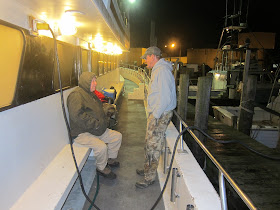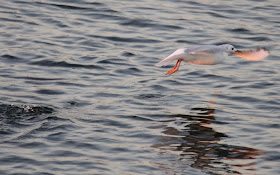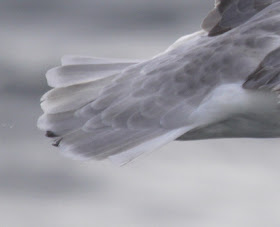Codfishing Pelagic
I picked up Dad at 4:15 am, and in a little over an hour and fifteen minutes, we were at the Frances Fleet docks. And to our great surprise, the wind was near calm, and the water in the harbor was mirror smooth. After we reserved our usual rail positions, there was time for a cup of coffee or two and a little story-swapping fish tales with the other fisherman on board. As the dawn tip-toed over the east, the crew readied the Gail Frances, and Capt. Richie DeLuca cranked over the diesels. The Harbor was starting to come to life as many of the fishing fleets vessels rumbled from their grumbling diesels.
Lady Frances getting an early start for Tautog and Cod
My Father-in-Law (left) sharing a few fishing stories
Lady Frances getting an early start for Tautog and Cod
My Father-in-Law (left) sharing a few fishing stories
As the Gail Francis untied its lines, it crept out of its slip and into the harbor. The near distant geometric lines from the outriggers of the fishing fleet framed the morning, highlighted by the impassioned dawn.
When the Gail approached the “narrows” near the Fisherman’s Co-op, Bonaparte’s Gulls were feeding along the outer docks, just port of the Gail.
Their feathers hugged the ambient colors offered from the sunrise, staining their soft grey and white plumages with gentle glows of pink and orange.
While I was photographing this single Bonaparte’s Gull, a second gull, a slightly larger one flew into the viewfinder of my camera. The gull was a Black-headed Gull, a cousin to the Bonaparte’s Gull, and a traditional uncommon visitor to the area in both winter and spring. Usually in the company of other Bonaparte’s Gulls or Ring-billed Gulls, this species is always a delight when it makes an appearance in New England .
I was only able to take a few images of this bird (unfortunately back-lit) as we passed the bird, it flew up the harbor, and I was out of position for additional shots. This was a very lucky encounter with this species it literally flew into my view. For a better look at this bird, see the excellent image taken by Paul L’ Etoile
( http://ribird.org/albums/photos_2011 ). Heading into the Harbor of Refuge
The beautiful orange sky invited the Gail to the open sea as small groups of Eiders, Scoters, Red-breasted Mergansers and Loons flew in all directions across the harbor like spirited moves on a large checker board.
Red-breasted Mergansers (2 pair)
Common Eiders
As the Gail passed through the opening in the sea walls, the predicted flat waves covered the ocean like a plush woven carpet, a very inviting sight for December. As we steamed towards the southeast, Capt. Richie announced that he was going to “check out a few new locations” which included Coxes Ledge since he hadn’t been out to the ledge in some time. As a big smile crossed my face, the sky was alive with Gannets, Scoters, Eiders, and Loons of both species.
drake Common Eider
adult Gannet
Common Scoters (above), Common Eiders (below)
Common Scoters (above), White-winged Scoters with 2 Common Scoters (below right)
Red-throated Loon (below)
Red-throated Loon (above), Common Scoters (below)
White-winged Scoter pair (above), Surf Scoter pair (below)
Common Scoters (below)
The morning was gorgeous under the dome of a glowing sky, gentle winds and waves small enough to make harbor ripples jealous. I sensed that this was going to be a great day for a pelagic trip. I wanted to be the first person to greet the sea by getting as close to it as I could. This brought me to my favorite spot on the vessel; the tip of the pulpit. About fifteen minutes of sailing, a single Common Loon emerged from under the sea only twenty yards in front of the bow of the Gail. The bird appeared stunned to see the vessel heading in its direction, and it casually swam out of the way of the Gail. The Loon swam under the pulpit so close I wasn’t able to capture the whole bird in the lens of my camera.
By now the sun had cleared the horizon, and the bright orange had changed to a soft piercing blue. The Gale steamed southeast heading directly into the bright sun. This of course made viewing difficult, so I had to look either side of the sun’s bright and vast reflection on the sea. This would later improve as the sun’s greater angle pulled farther away from the horizon. As the Gail passed east of Block Island , the first alcid; a Common Murre crossed paths with the Gail about a hundred yards out and disappeared into the sun. Within a minute, a second Common Murre, than followed by a Razorbill, each bird coming from the east and fading into the sun. As the third Common Murre came into view a short time later, it was soon followed by another alcid. Its shape different, short, stubby bill, it was a Puffin. I took a couple of long shots before it got lost into the sun. Unfortunately, the images revealed nothing more than a blurry black speck against a bright overpowering background.
As the Gail turned slightly east, the sun passed slightly to the starboard making spotting perfect, unobstructed from the intense reflection. As Capt. Richie searched for “Sand-Bank Ledge” another Common Murre passed closely off the bow……..
………and another Common Murre, this one was sitting on the water and skittered across the sea as the Gail approached its destination.
When the diesels slowed, I spotted the first pair of my “bird de jour” about a hundred yards out heading directly away. The two Dovekies flew to the horizon, offering only a few seconds of a parting glimpse before quickly vanishing.
The Capt. announced it was time to fish, and everyone’s lines raced to the bottom. As the first Cod and Sea Bass made their way to the surface, another single Common Murre passed by the bow offering another fine view of this exciting sea bird.
We drifted throughout the area for an hour or so, and a steady stream of codfish and sea bass made their way into everyone’s coolers and burlap sacks. The sea was busy with birds trading back and forth: Gannets, Razorbills, Common Murres and other large unidentified Alcids, Common and Red-throated Loons, and sea ducks mostly Common and White-winged Scoters.
White-winged Scoters (above), Common Loon (below)
Common Murre (below)
Interesting! This adult Gannet decided to preen its mantle while it was flying!
The Captain announced it was time to “reel em’ up” its time to head out to Coxes, about ten miles east. When the Gail came about and steamed east, the first Fulmar of the day appeared from the north at two hundred yards and paralleled the Gail for half a mile.
After a couple of miles a distant Kittiwake appeared, but faded into the horizon.
When we approached the northeast edge of Coxes Ledge at “Old Baldy”, I spotted three little black and white birds swimming just off the port bow. These small birds looked like floating ping-pong balls riding buoyantly high on the sea. The Gail got closer and the three Dovekies came within twenty yards of the vessel. It seemed that I could reach out from the pulpit and almost touch them. This was fantastic; this is what I was looking for. After traveling thirty miles in the open sea, and to have these three birds appear mere yards out was heart-warming. I looked back to Capt. Richie and gave him the “thumbs-up”, he waved back, I know he understood my excitement!
As we continued east over Coxes, more and more Dovekies appeared floating on the sea in singles, pairs, trios, and small groups. Some were again close to the vessel, others were in the not-so-far distance.
When the Gail reached the fishing grounds, the lines were again cast over and the cod began to bite. More and more Dovekies appeared on the sea, and small groups were flying across the Ledge some stopping and other kept on their way.
A Dovekie decoy I carved in the style of Elmer Crowell.
With the little Alcids came their larger cousins: Razorbills and Common Murres. (In later reviewing of my images, I discovered that there were many Common Murres in the mixed flocks of unidentified large alcids).
Common Murre
(below) Razorbill (left) and Common Murre (right)
(below) Common Murre
(below) mixed flock of Razorbills and Common Murres
(from l to r)- imm. Razorbill, Common Murre, imm. Razorbill, Common Murre, Common Murre (behind) and Common Murre
immature Razorbills (below)
Razorbills (below)
two Common Murres (below)
The alcids stopped flying in the early afternoon. After six hours of continual birds from every direction, the sea was suddenly quiet. The only birds being a distant Gannet, Loon or Gull including this single Bonaparte’s Gull flying over the outer reaches of Coxes.
I looked around, and there wasn’t a single Gull within a mile of the Gail. This is quite unusual because of all the tossed over bait and small returned fish, there is always at least a pair of Greater Black-backed Gulls vigilantly keeping watch for these tossed over offerings. But this time was different, there were no Gulls. I looked around but the sea was empty of wings. After a brief conversation with Dad (who sternly secured his corner rail position) and a quick look into our nearly filled cooler, I thought it might be a good time to think about chumming. I had over fifteen pounds of cut suet with me, I just needed a few Gulls to get it started. As if almost on cue, I noticed a pair of Greater Black-backed Gulls appearing from the horizon, and both were headed directly for the stern of the Gail. One of the birds landed off the starboard stern.
I secured my chum pail to the rail, and offered the first spoonful to the Gull. It worked perfectly. With a loud cry, the excited gull announced to the whole ocean that it was feeding time! The second Gull appeared, and from out of nowhere, here came the Herring Gulls. Within two minutes and three spoonfuls of suet, there were over a dozen Gulls feeding along the floating suet which had now drifted away from the Gail with the tide.
With the loud commotion from the screaming Gulls came the first Fulmar. It circled the vessel twice, located the floating chum and landed on the water gorging itself with the suet.
Then the second Kittiwake of the day came from the east. It also circled the Gale and landed in the chum line……..
I continued to send more suet into the water as the numbers of Gulls, Fulmars and Kittiwakes increased. At one point there were three Fulmars and a dozen Kittiwakes coming to the chum line.
The day grew long and our time on Coxes had come to an end. With the announcement from Capt. Richie to “reel em’ up” the Gail Frances steamed home for port. As I mentioned in earlier pelagic reports, this is my favorite time on a cod trip. When the mates started cleaning the fish, the numbers of Gulls, Fulmars and Kittiwake increased, now being joined by Gannets.
four Kittiwake (above) three (below)
This is the first immature Kittiwake I have seen this winter. The black wing "M" is very clear in the last photo in this series.
As we steamed home, the view behind the Gail was like a scene from the Alfred Hitchcock’s famous movie “The Birds”. The sky was filled with a long trail of feeding and diving birds, and at one time I counted nearly thirty Kittiwake.
three Kittiwake
six Kittiwake (below)
A few "close-ups" of this wonderful sea bird. Good view of the "nares tube" and short but strong bill including its large maxillary "unguis" or "nail of this classic "tube nosed" pelagic bird
tail area showing grey upper tail coverts
close-ups of the whte outer wing "flags"- a common field mark for this bird
When the Gail started shortening the distance to port, the Fulmars numbers diminished, but the Kittiwake continued.
As the vessel passed by northeast of distant Block Island, the pre-sundown colors illuminated the late afternoon sky with brilliant values of orange and pink, just as it had from the east nearly eight and a half hours earlier.
As the vessel passed by northeast of distant Block Island, the pre-sundown colors illuminated the late afternoon sky with brilliant values of orange and pink, just as it had from the east nearly eight and a half hours earlier.
The day ended just as it began with birds crossing paths with the Gail as it steamed along. The white plumage of the birds now bathed in the warm glow of the afternoon sun added a beautiful contrast to their soft white plumages.
As the Gail passed through the east wall passage, a flock of Common Eiders flew across its bow.
drake Surf Scoter (below)
Bonaparte's Gulls (below)
Surf Scoters (below)
Surf Scoters with three Ruddy Ducks (below left) in the image
A trawler heading out to sea was enveloped in the rich brilliance of sundown.
Passing through the "Narrows" a Red-throated Loon surfaced a few feet fore of the port bow, ironically just as the Common Loon did that morning. It skittered across the water to a safer distance from the Gail.
Passing the North dock, a Harbor Seal and a single hen Common Eider welcomed us back.
As Capt. Richie tucked the Gail into its slip, the sun closed its eyes over Matunuck, ending a spectacular day. With a cooler full of Cod and Sea Bass, we drove for home, with the memory of this great day tucked in our smiles.
My hopes for spending a day with the Little Auk was a wonderful success. The day was perfect, with birds that were flying non-stop all day. With four species of Alcids, Gannets, Sea Ducks, Fulmars, Loons, Kittiwakes, Bonaparte’s and a Black-headed Gull, it made for a very memorable New England winter sea bird experience.
The chart images below indicate the general locations of the birds (not an exact GPS plotted chart). BHG= Black-headed Gull, CM= Common Murre, Rz= Razorbill, Dv= Dovekie, F= Fulmar, K= Kittiwake, BonG= Bonapartes Gull. L1-L2 return trip location.
Just as in my last pelagic/codfishing report, I have included fishing images below the highlights.
The chart images below indicate the general locations of the birds (not an exact GPS plotted chart). BHG= Black-headed Gull, CM= Common Murre, Rz= Razorbill, Dv= Dovekie, F= Fulmar, K= Kittiwake, BonG= Bonapartes Gull. L1-L2 return trip location.
Just as in my last pelagic/codfishing report, I have included fishing images below the highlights.
Here is the list of highlights-
The numbers marked with a “*” are accurately counted, others are rough estimates.
*51 Dovekie (most were swimming within fifty yards from the bow of the vessel, and some flying and swimming a short distance away) There may have been more, but I was concentrating on the birds closest to me. *1 Atlantic Puffin- (flew by as a single in the area between the Sand Bank rip (east of Block) and steaming to Coxes. The bird was a good distance from the vessel, and flew through the sun) 75+/- large Alcids- (after reviewing my images) at least 17 Common Murre and 23 Razorbills (positively identified) the balance were a bit too far to call. 200 +/- Gannets 36 +/- Common Loons *17 Red-throated Loons *13 Fulmar50+ Black-legged Kittiwake. *16 Bonaparte's Gulls (including 1 seen on Coxes Ledge)*1 Black-headed Gull60-75 Common Eider
150+/- Scoter species (mostly Common and White-winged)
*3 Oldsquaw
*46 Red-breasted Mergansers
*46 Red-breasted Mergansers
*3 Ruddy Duck
Keith Mueller Killingworth, CT
A very large Common Eel nearly three and a half feet long (above), Dad with another Sea Bass for the cooler (below)
Larger Codfish (below)
Atlantic Pollock (below)
Red Hake (below)
Fluke (below)
two more large Codfish



























































































































































































































































































